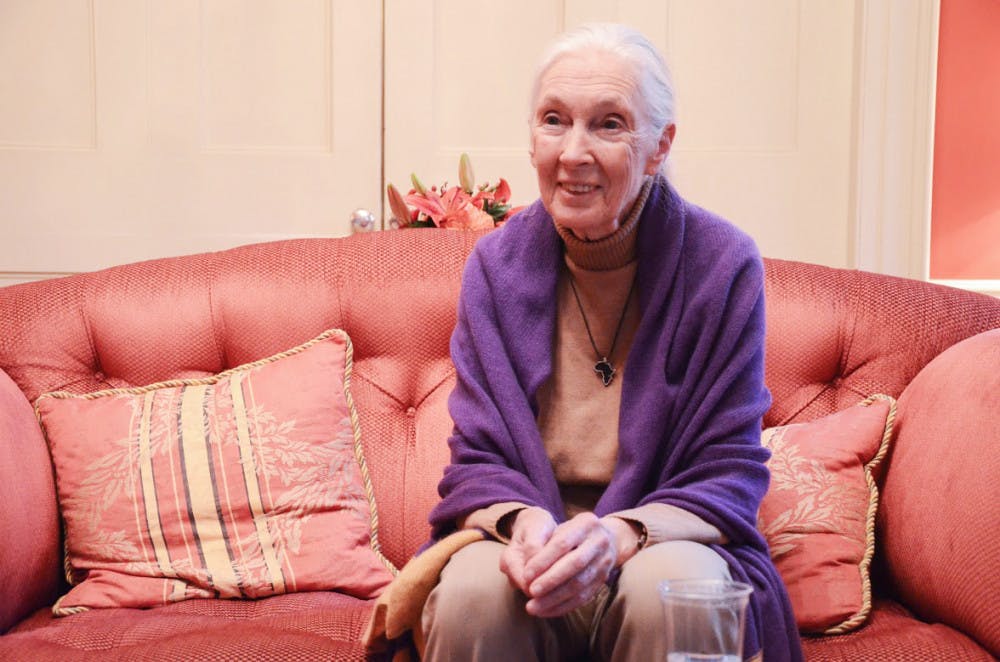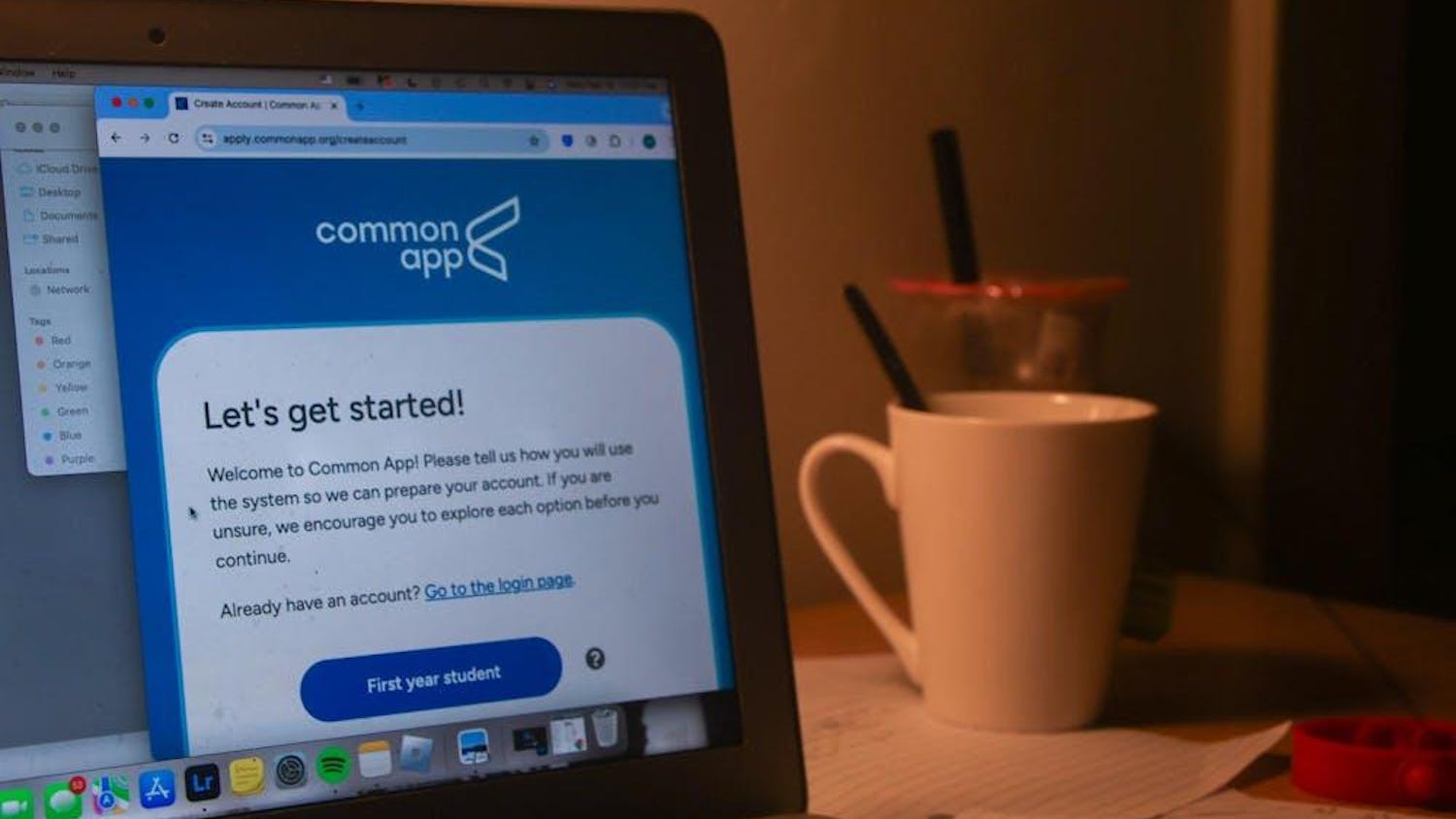Jane Goodall took the stage Monday night wearing a bright purple shawl and a necklace bearing a symbol of the African continent.
“I would like to start off by bringing into this space the voice of the being that I spent so many years learning about,” Goodall said. “Oooh oooh eeeh eeh ahhh. That’s ‘this is me’ in chimpanzee language.”
Goodall spoke in a packed Salomon 101 during a lecture sponsored by Brown Lecture Board. Over 750 people attended the event, which had the most lottery entries of any lecture in University history, said Viet Nguyen ’17, co-president of Lecture Board.
A world-renowned chimpanzee expert and outspoken environmental activist, Goodall spent the hour-long talk describing her journey, which began with a childhood obsession with animals, a healthy dose of curiosity and a compassionate and supportive mother.
“There was a special second-hand bookshop where I lived as a child. And when I was 10, I found a wonderful book — “Tarzan of the Apes” — and I had saved up just enough pocket money to buy it,” Goodall said, adding that the book stirred up her dream of traveling to Africa to live with wild animals. “There I am, in love with Tarzan, and what did he do? He married the wrong Jane.”
Goodall said she received a secretary degree because a college degree was too expensive. “World War II was raging, and there just was not a lot of money.”
At 23, she received an invitation from a school friend to visit Kenya. After working for four months to save up money for the fare, Goodall left England solo for Africa. Soon after her arrival, she met with Louis Leakey, a famous archaeologist who later became her boss and mentor.
Goodall said Leakey asked her hundreds of questions. “Because I had spent hours in the Natural History Museum in England and had read so many books, I was able to answer most of his questions. He hired me on the spot,” she said.
Goodall helped Leakey and his wife conduct field work in the plains of Africa. Leakey later picked Goodall to research apes on a project he had been planning due to his interest in the evolutionary history of apes and their connection to humans.
Equipped with only “a pair of binoculars and a notebook,” Goodall and her mother set out for Gombe National Park in Tanzania to begin what became a 55-year study of the social and family interactions of wild chimpanzees.
“People told me, ‘Oh, Jane, you’re so brave.’ But I wasn’t brave at all! It was just my dream!” Goodall said.
Several months into the project, Goodall was just beginning to run out of hope when she made one of her biggest discoveries. “I saw a chimpanzee crouched over a termite mound. I saw his hand pull out a grass stem and shoot down into the termite mound. He pulled the stem out carefully, termites crawling all over it, picked out the insects with his lips and crunched them up,” Goodall said. “He made a tool!” This discovery brought in money, support and a photographer from National Geographic, leading to an international spotlight on her research.
Leakey arranged for Goodall to study ethology at Cambridge University, where she became the eighth person at Cambridge to study for a PhD without having obtained an undergraduate degree.
“The professors told me I had done everything wrong. I couldn’t talk about the chimps having personalities. I couldn’t talk about them having emotions,” she said. “Fortunately, when I was little, I had a teacher who taught me that all those professors were wrong about animals. That teacher was my dog, Rusty.”
After completing her PhD, Goodall returned to Gombe, where she continued her research on chimps. “The more I learned, the more it became obvious that there wasn’t a sharp line dividing us from the rest of the animal kingdom,” Goodall said. “Human beings are not the only beings with minds, personalities and emotions.”
Goodall said she believes chimpanzees have the ability to show love, compassion and true altruism. As evidence, she explained how she once observed a 12-year-old male chimp named Spindle adopt and nurture a 3-year-old chimp named Mel. Spindle carried the infant around on his back and shared food with him, as Mel’s mother would have done, Goodall said.
In 1987, Goodall left Africa to attend a conference in Chicago, where several scientists gathered to discuss conservation efforts and abuse of chimpanzees within the medical research field.
“I went to this conference ... and without any conscious decision, I left as an activist,” Goodall said. “Ever since, I’ve been traveling around the world and talking about the plights faced by chimpanzees.”
As she traveled and spoke with other scientists, she learned “more and more about what we have done to our planet.”
“We are the most intellectual species that has ever walked on human earth. So why is it that we’re destroying the planet?” she asked. “It’s kind of a mess that we’ve made.”
After meeting with a group of 12 concerned high school students in Tanzania in 1991, Goodall founded the youth-led community action program Roots and Shoots. Now spanning 130 countries, the group carries out service projects aimed at conservation.
“I asked a question earlier — how is it possible that we are destroying our home? We’ve lost something called wisdom — making decisions based on how it will affect the future,” Goodall said. “Somehow, we have to reconnect this immensely clever brain with the human heart, with love and compassion,” she added.
Goodall ended the talk by playing a video of a wounded chimp named Woonda locking Goodall in a passionate embrace and then hunkering off into the forest.
After the lecture ended, students asked Goodall questions during a 15-minute question-and-answer session.
“She was amazing and inspiring,” said Greg Lowry ’17. “Her message about how each individual can make a difference is so relevant to everybody, especially University students who have the power to go out and promote change,” he added.
“I like the work she’s done in terms of biology conservation and how she’s a role model for many young scientists. I’m mostly just inspired with what she was able to do early on in her career in the ’60s and her inspiration for women in STEM,” said Sydney Clark GS.
A previous version of the story quoted Jane Goodall as saying, “That’s ‘this is me’ in monkey language.” In fact, she said, “That’s ‘this is me’ in chimpanzee language.” The Herald regrets the error.





